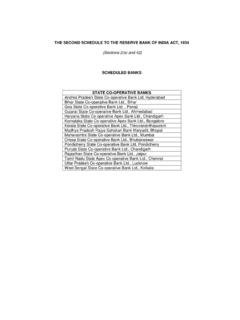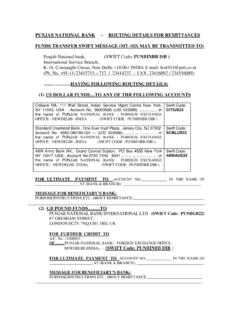Transcription of How Banks Go Abroad: Branches or Subsidiaries? …
1 How Banks Go abroad : Branches or subsidiaries ? eugenio cerutti , giovanni dell Ariccia, and Maria Soledad Martinez Peria* Abstract This paper examines the factors that influence Banks choice of organizational form when operating in foreign markets, using an original database on the operations in Latin America and Eastern Europe of the top 100 international Banks . We find that regulation, taxation, the degree of desired penetration in the local market, and host-country economic and political risks matter. Banks are more likely to operate as Branches in countries that have higher corporate taxes and when they face lower regulatory restrictions on bank entry, in general, and on foreign Branches , in particular. subsidiaries are the preferred organizational form by Banks that seek to penetrate the local market establishing large and mostly retail operations. Finally, there is evidence that economic and political risks have opposite effects on the choice of organizational form, suggesting that legal differences in the degree of parent bank responsibility vis- -vis Branches and subsidiaries , under different risk scenarios, play an important role in the type of operations international Banks maintain overseas.
2 JEL: F23, G21 Keywords: foreign Banks , organizational choice Johns Hopkins University, International Monetary Fund, and World Bank, respectively. We thank Ugo Panizza and researchers at the Inter-American Development Bank for providing us data. The findings, interpretations, and conclusions expressed in this paper are entirely those of the authors and do not necessarily represent the views of the World Bank, the IMF, Executive Directors at these institutions, or the countries they represent. Contact information: Maria Soledad Martinez Peria, The World Bank, 1818 H Street, , Washington , 20433. Phone: (202)458-7341. Fax: (202)522-1155. E-mail addresses: I. INTRODUCTION Over the last two decades, many countries liberalized bank activities that traditionally had been heavily regulated and protected from competition. As part of this process, foreign Banks , which had previously played only a marginal role, have established a substantial presence in the banking systems of several middle-income and developing countries.
3 That presence has taken a variety of forms, ranging from the acquisition of domestic institutions with extensive branch networks to the establishment of isolated representative offices aimed at serving niche market segments. However, in contrast to the growing debate on the merits and pitfalls associated with an extensive foreign bank presence in emerging markets, little attention has been paid to how that presence is established. In this paper, using a newly put together database on the activities of the top 100 international Banks worldwide, we try to fill this gap by examining what factors affect the organizational form under which Banks choose to operate in foreign markets. We focus on their operations in Latin America and Eastern Europe, the two regions that have witnessed the largest increase in foreign bank participation over the last decade. In both regions, current levels of foreign bank participation exceed 50 % of banking system assets in many countries.
4 There are at least two sets of reasons policy makers, bank users, and bankers should care about how foreign Banks operate in host markets. First, the organizational form of foreign bank operations may affect the competitive structure of the local banking systems, threatening the profits and market share of domestic Banks and also affecting the price and quality of banking services in the host-country. For example, foreign subsidiaries with extensive networks are in direct competition with local commercial Banks for retail clients, while single-branch foreign Banks or representative offices concentrate, instead, on segments such as wholesale and investment banking, which are typically undeveloped in the host countries. Second, Branches and 2 subsidiaries typically involve different levels of parent bank responsibility and financial support. While subsidiaries are separate entities from their parent Banks , under most circumstances, parent Banks are responsible for the liabilities of their This has implications not only for the parent bank but also for local regulators, who care about the stability of the host-country, and for local depositors, who care about the safety of their savings in their country.
5 We build an empirical model that allows Banks organizational choice to depend on parent bank characteristics, home-country regulations, the desired level of penetration in the host market (as proxied by affiliate bank characteristics) and host-country factors. In particular, we allow the parent bank s size, business orientation (wholesale versus retail), degree of international presence, and past expansion strategies to affect their choice of organizational form in a given host-country. We measure the desired level of penetration in the host market by controlling for the affiliate size and business orientation. Among the host-country factors we consider the impact of legal restrictions on foreign bank operations, entry requirements, and corporate taxes. Also, we examine whether differences in the degree of legal responsibility by parent Banks vis- -vis the liabilities of their overseas Branches and subsidiaries play a role in the choice of organizational form.
6 If these differences indeed affect Banks decisions, Branches would tend to be the preferred organizational form in host countries characterized by relatively higher economic and political risks. This question is empirically relevant, especially considering that in practice the distinction between Branches and subsidiaries in times of crisis may be much more blurred due to 1 The recent crisis in Argentina provides us with examples of the different type of behavior of Branches and subsidiaries in line with their legal responsibilities regarding their local liabilities. While Citibank announced an increase in the capital of its branch operations in Argentina, it opted for selling its subsidiary (Bansud). Also, in Argentina Credit Agricole decided to cut its losses by letting the government take over its subsidiaries Bersa, Bisel and Suquia. In Eastern Europe, the Bayerische Landesbank gave up its subsidiary Croatian Rijecka bank after a trader at the subsidiary incurred huge foreign exchange losses.
7 3 special contractual arrangements (such as ring-fencing provisions) and reputational considerations. On the one hand, ring-fencing provisions may limit the losses faced by parent Banks when their Branches are in trouble. Such provisions generally establish that parent Banks are not required to repay the obligations of a foreign branch if the branch faces repayment problems due to extreme circumstances (such as war or civil conflict) or due to certain actions by the host government ( , exchange controls, expropriations, etc.). In recent years, a number of banking groups have adopted ring fencing On the other hand, concerns about loss of reputation have in certain instances lead parent Banks to rescue and recapitalize subsidiaries , even if they were not legally forced to do Our findings confirm some of our expectations, but also pose new questions, and challenge some established views.
8 First, regulations and institutional factors appear to have a paramount effect. Foreign Banks are less likely to operate as Branches in countries that limit their activities and where regulation makes it difficult to establish new Banks . Branches are, instead, more common in host countries with high corporate taxes possibly because of the greater ease allowed by this structure in shifting profits across borders and in poor countries, perhaps because of fewer market opportunities. 2 In the case of bank Branches section 25C of the Federal Reserve Act establishes that a member bank shall not be required to repay any deposit made at a foreign branch of the bank if the branch cannot repay the deposit due to an act of war, insurrection, or civil strife or (2) an action by a foreign government or instrumentality (whether de jure or de facto) in the country in which the branch is located, unless the member bank has expressly agreed in writing to repay the deposit under those circumstances.
9 Another example of ring fencing provisions are the clauses included in the International Swaps and Derivatives Association (ISDA) Master Agreement. These Ring-Fencing Provisions stipulate that the headquarters will bear no responsibility for transactions made at overseas Branches in the case of exchange controls or expropriation (see ISDA (2003), Section 10 (a) Ring-Fencing Agreements). 3 For example, HSCB injected more than $600 millions into its Argentine subsidiary following the crisis in that country (Economist Intelligence Unit Wre, December 16, 2003). Similarly, Portugal s Banco Espiritu Santo injected more capital into its Brazilian subsidiary Banco Boavista Interatlantico, after the latter had to make good on the losses sustained by its mutual funds following the Real s devaluation of January 1999. ABN Amro and KBC promised to make good on any losses to clients arising from an alleged fraud at their Hungarian subsidiary K&H equities (The Economist, Septemb2003).
10 4 Second, our results suggest that different organizational forms are associated with different degrees of penetration in the host market. Branches are more likely when foreign operations are smaller in size and do not have a retail orientation. Third, host-country risks matter, and in particular, economic and political risks have opposite effects. Branches are less common in countries with highly risky macroeconomic environments, where parent Banks seem to prefer the shield of hard limited liability provided by subsidiaries to the soft protection of ring-fencing. However, when it comes to risks stemming from possible government intervention and other major political events, parent Banks are more likely to operate as Branches . This is not necessarily surprising. In view of legal provisions that shield parent Banks from the liabilities of their foreign Branches in events such as wars, insurrections, or arbitrary actions by foreign governments.















